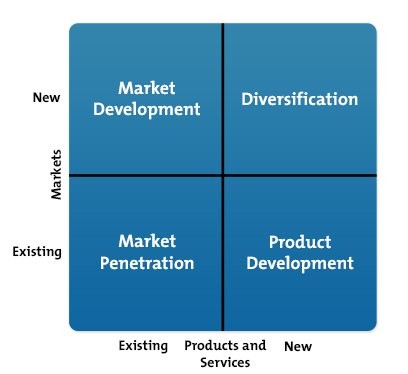Successful business executives recognize that for sturdy growth of their organization, they often need to change strategies. They cannot afford to stick with the same old strategic tools and decisions. They need to find new ways to increase profits and reach new customers. There are numerous options available, such as developing new products or opening up new markets, but how does one know which strategy will work best for his/her organization? Ansoff Matrix helps in such situations.
History: The Ansoff Matrix was developed by H. Igor Ansoff and was published in the Harvard Business Review in 1957; he wrote it in an article titled “Strategies for Diversification.” Ansoff was primarily an expert mathematician; he also had insight into business management. It is believed that he has contributed to the subject of strategic management his thoughts and ideas. Ansoff has mentioned the healthiest and the weakest strategy in his matrix.
With passage of time, Ansoff Matrix was widely used in the business world which is also known as the Product/Market Expansion Grid. The Matrix shows four strategies for business growth. It also helps to analyze the risks associated with each one. The design is such that each time one moves into a new quadrant (horizontally or vertically), risk increases. Ansoff Matrix has 4 quadrants with Products on the X axis and market on the Y axis, both showing existing and new products/ services and markets. The matrix gives four strategies as follows:
Market penetration is seen in the lower left quadrant, it is the safest of the 4 strategic options. Under this option, the focus is on expanding sales of the firm’s existing products in its existing market. The firm knows that the product works, and the market holds few surprises for the firm.
In Market Penetration, the risk is the lowest since the products are already familiar to the consumers and so is the established market. Another way in which market penetration can be increased is by coming up with various initiatives that encourage increased usage of the product. A good example is of Diet Coke. It has been a success for Coca-Cola, but its consumers are overwhelmingly female. Men don’t drink it because they think of it as a girly soft drink. Coca-Cola’s solution: it brought Coke Zero which offers the same benefits as Diet Coke (Coke taste with no calories) but it’s seen as more of a “guy’s drink.” This opened up a whole new market; growing sales of existing products in existing markets. In another instance, Starbucks started writing names of customers on the coffee cups. The intention of this was to increase sales and greater customer satisfaction.
Product development falls in the lower right quadrant, is slightly more risky, because a firm introduces a new product into its existing market. Product development involves creation of products with new or different characteristics that offer new or additional benefits to the customer. It also sometimes involves modification of an existing product or its presentation, or formulation of an entirely new product that satisfies a newly defined market niche. Product development is not synonymous with product management, although many people mistakenly use the terms sweepingly. Indeed, product development does not refer to a single role at all. Example of product development is converting land line phones into wireless handsets for easy portability and full-time access to communication. Another example is modifying desktop computers into light-weight laptops to ease portability. In case of Starbucks to increase sales of coffee they launched new premium coffee with exceptional and exclusive beans.
Market development is seen in the upper left quadrant. Marketers put an existing product into an entirely new market. Sometimes it is used by finding a new use for the product, or by adding new features or benefits to it. The marketer may do this by promoting the product in a new geographical area or it may try to present it in different media. A market development strategy targets non-buying customers in currently targeted segments. It also targets new customers in new segments. McDonald opts for market development by reaching more customers in markets where it already has operations. For example, McDonald’s opens new restaurants in North America and Europe by franchising, joint ventures or corporate ownership. A strategic objective connected to this market development strategy is global expansion through new locations. McDonald’s general strategy supports this intensive growth strategy because low costs and low prices empower the firm to easily penetrate markets.
Diversification is seen in the upper right quadrant. It is the riskiest of the four options, because here a firm introduces a new, unproven product into an entirely new market which may not fully understand it. In this strategy, there can be further exploitation of the products without necessarily changing the product or the position of the product. This becomes possible through the use of promotional methods, putting various pricing policies that may attract more clientele, or firms improve their distribution channels more extensively.
A related diversification is one in which the involved businesses have meaningful commonalties; for example, a manufacturer of computers might begin making calculators as a form of related diversification of its existing business. Unrelated Diversification is a form of diversification when the business adds new or unrelated product lines and penetrates new markets. For example, a shoe producer enters the business of clothing manufacturing. Related diversification makes more sense than unrelated because the company shares assets, skills, and human capabilities. But, many successful companies have entered unrelated diversified businesses and becoming successful at them.














































